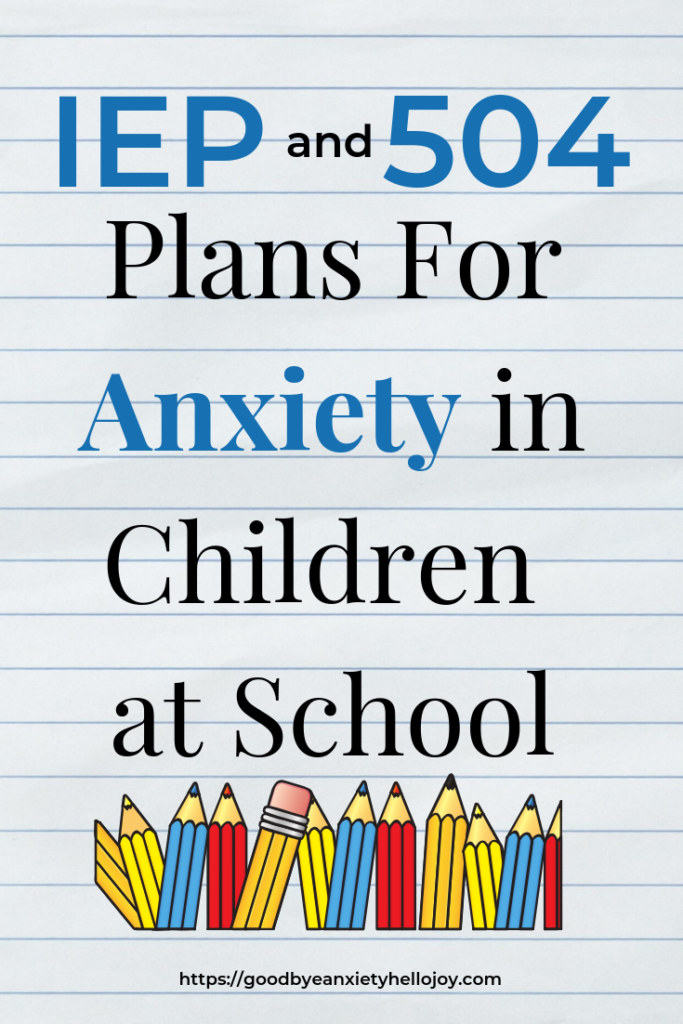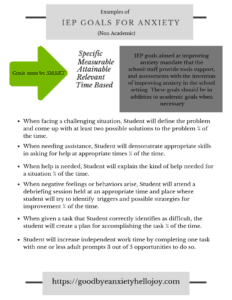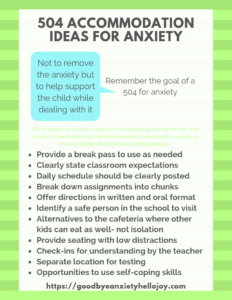
IEP and 504 Plans for Anxiety in Children at School
IEP and 504 Plans for Anxiety
You realize your child’s anxiety is impacting his or her school experience but you don’t know what to do about it? Who do you talk with?  What can be put in the place to help your child? How can you feel heard and understood? These concerns are some of the most often asked questions I hear among parents with an anxious child. The good news is that IEP and 504 plans for anxiety are available and offer great support. (If you have not purchased Helping Children Manage Anxiety at School, check it out. This is an amazing resource for parents and teachers in helping anxious children to succeed at school. )
What can be put in the place to help your child? How can you feel heard and understood? These concerns are some of the most often asked questions I hear among parents with an anxious child. The good news is that IEP and 504 plans for anxiety are available and offer great support. (If you have not purchased Helping Children Manage Anxiety at School, check it out. This is an amazing resource for parents and teachers in helping anxious children to succeed at school. )
Today, I will provide a brief overview of IEP and 504 accommodations for anxiety, giving you the ability to start working with the school to help your child manage their anxiety while thriving academically and socially. The goal with any type of accommodations for anxiety is to put a plan in place that helps a child learn to manage anxiety and includes a weaning process as their anxiety improves. The steps below outline how IEPs and 504s are created to help children with anxiety succeed at school.
As I always mention, all children with anxiety are unique. These ideas are a starting point. The age and level of anxiety, your child’s experiences, and the school your child is attending will greatly affect the plan put in place to help your child. Please reach out if you have specific questions about your child.
If you are unfamiliar with IEP meetings, how they work, and what to expect, A Parent’s Guide to IEP Meetings from Garforth Education provides a lot of useful information.
How do I know if my child could benefit from accommodations at school?
Children of all ages are affected with anxiety yet manage to attend school will little to no effect on their academic experience. If you notice that your child’s anxiety is impeding their ability to attend school and learn on a regular basis, then he or she may benefit from accommodations. Additionally, anxiety is often a “comorbid” illness, meaning it occurs along with other illnesses or disorders. In these cases, IEPs and 504s can be used to create a plan to address both the anxiety needs as well as the needs associated with the other illness or disorder. If anxiety exists as the only area of need, then a plan can be created focusing on the anxiety.
Accommodations can range from minimal in a 504 such as “small group testing” to complex with many accommodations and/or modifications for anxiety that leads to school refusal. The key here is that the anxiety must be extreme enough that your child is no longer able to learn in a typical school setting in ways similar to peers.
What is an IEP and 504?
IEPs and 504s are both formal plans offered to students to help them succeed at school. They contain some similar features but there are key differences. For either option, parents can request that their child is evaluated for additional services at any time. Once requested, school personnel will begin working with parents and the child to gather information from teachers and parents to see what, if any, services could benefit the child.
IEPs have two requirements in order to obtain: A child has 1 or more of the 13 specific disabilities listed in IDEA (Individuals with Disabilities Education Act). A child’s listed disability must impact his or her educational performance and/or the ability to benefit from the general education curriculum, leading to the need for specialized instruction.
 An IEP is more in-depth and more specific than a 504, which include identifying areas of need, services that will be provided, annual goals, and definition of how progress will be measured in order to meet the goals. IEPs require that parents participate in the process.
An IEP is more in-depth and more specific than a 504, which include identifying areas of need, services that will be provided, annual goals, and definition of how progress will be measured in order to meet the goals. IEPs require that parents participate in the process.
504s offer more flexibility by allowing a child with any disability that interferes with learning in the general education environment. A child who does not qualify for an IEP may qualify for a 504. Parents are encouraged to be a part of the 504 plan but they are not required to participate in the process. Additionally, areas of need and services provided are included in a 504 but annual goals are not set.
Please note that there is a legal difference between an accommodation and a modification. Accommodations change HOW the child learns the material. Examples include listening to a text rather than reading it, seat placement within the classroom, or time allowed on an assignment or assessment. Modifications change WHAT a child is taught or expected to learn. Examples include reading a shorter text or learning math at a lower level. The team put into place will decide what accommodations and/or modifications are best for your child’s current situation. IEPs and 504s can be modified as the need arises, but do require proper documented support and a formal discussion in order to make that happen.
How can I request an IEP or a 504?
If you begin noticing that your child’s anxiety may be causing difficulties either academically, emotionally, or socially, begin documenting what you see. For example, if your child’s grades begin declining, complaints about school rise, behavior incidents escalate, or any other noticeable differences, note the dates and occurrences. If you discover a pattern tied to anxiety, reach out to your child’s teacher and get his or her opinion on what is occurring throughout the school day. Once you conclude that anxiety may be impacting your child’s school experience, write a letter to the director of Special Education for your local school district requesting an evaluation. Make sure to include all of your child’s information as well as your concerns along with support documentation. The evaluations provided by a school district vary, so be sure to ask for information on this process.
Schools seldom offer any type of formal diagnosis, rather they will provide evaluation results showing areas of concern, allowing discussions around ideas to support your child in their areas of need.
Once a child has been deemed eligible for services, the team has 30 days to develop a plan. The team consists of school staff and parents. During this time, depending on evaluation results, outside medical records if available, and parent and teacher’s observations, it will be decided if a student is eligible for an IEP or a 504. From there, accommodations, and at times, modifications will be discussed.
What is my role, as a parent, during this process?
You are your child’s biggest advocate and know him or her better than anyone else. It is important that you understand the process to the best of your ability. Enter the initial meeting informed about both your child’s rights and with ideas to help your child succeed. It is a team approach and the school cannot, alone, create a plan to support a student.
Attending an IEP or 504 meeting can feel intimidating, and parents often struggle when hearing their child’s weaknesses. Remember, in order for your child to get the support he or she deserves, the areas of need must be discussed. In most cases, your child’s strengths will also be highlighted as this is just as important to know and understand.
Prior to the meeting, ask any doctors, therapists, and teachers for their thoughts on ways to help your child succeed while at school. It is best to come with many ideas to share, allowing the team to discuss many options in order to find the best ones.
Once the meeting has concluded, the document needs to be signed in order for it to be legal. Most often, you will be asked to sign the document at the end of the meeting. If you feel unsure, you have the right to take the document, think about what was discussed, and sign at a later date, then return. You also have the right to not sign the document.
How can an IEP or a 504 help my child with anxiety?
It is important to note that no matter what accommodations are chosen, the child should first and foremost have an understanding of anxiety and be learning how to manage their anxiety. The accommodations put in place will be there to support the child while they gain the skills necessary to manage the anxiety, but should not be in place long term as a way to avoid the anxious situations. All accommodations should have a weaning-off process in place as the skills are acquired.
The sky is the limit on ways that these legal documents can assist a child with anxiety at school. Each child  is unique, therefore, the accommodations/modifications can be equally as unique. In many cases, anxiety can be reduced by small groups, consistent adults, breaks throughout the day, extra time for assignments and assessments, and advance notice for changes in schedules and times of transitions. All of these can be put in place in the beginning, but remember, the goal is to teach the child the skills needed to manage the anxiety. Once the skills are taught, a child should no longer need these accommodations. As a child gains the skills for managing the anxiety, it no longer benefits the child to be given extra time for assignments or to be notified ahead of time regarding schedule changes. With their newly acquired ability to manage anxiety, they will have the ability to complete work on time and to manage schedule changes with flexible thinking.
is unique, therefore, the accommodations/modifications can be equally as unique. In many cases, anxiety can be reduced by small groups, consistent adults, breaks throughout the day, extra time for assignments and assessments, and advance notice for changes in schedules and times of transitions. All of these can be put in place in the beginning, but remember, the goal is to teach the child the skills needed to manage the anxiety. Once the skills are taught, a child should no longer need these accommodations. As a child gains the skills for managing the anxiety, it no longer benefits the child to be given extra time for assignments or to be notified ahead of time regarding schedule changes. With their newly acquired ability to manage anxiety, they will have the ability to complete work on time and to manage schedule changes with flexible thinking.
For more severe anxiety, extra support can be offered by teacher’s assistance, intervention classrooms, less homework, a variety of ways to show learning, schedule adjustments, school counselor visits, avoidance of school hallways during congested times, or options during lunchtime other than the cafeteria. Once again, these should be allowed at the beginning of the anxiety management process but weaned-off as skills are learned. Anxious children will use these accommodations as long as they are allowed, as avoidance feels better than working through the anxiety. Avoidance does not lead to long term anxiety management. Parents and teachers must collaborate to make sure that the child is learning the skills to work through anxious situations rather than avoiding.
In some cases, there is a particular aspect of school that causes anxiety. For example, a young child had extreme anxiety while at school due to the automatic flush on toilets. Once this was discovered, a 504 was created, allowing her to use the faculty restrooms in order to avoid the automatic flushers. In another instance, a student was overwhelmed during group work. During this time, he was permitted to wear non-noise canceling headphones which allowed better focus on his work but still allowed him to hear the teacher when needed. As the child learned to handle these anxiety triggers, the accommodations were no longer needed.
Remember, the goal is to provide accommodations that encourage a child to understand and manage their anxiety and wean off of the assistance as their independent skills improve.
As you can see from these examples, it is important to know your child. This legal document will be created specifically for your child’s success.
For more detailed accommodations, please see Our IEP Plan for School Anxiety and Effective Strategies to Reduce Anxiety at School.
Please share in the comments below or email me with any success stories that could benefit others or with any questions you may have. It can be a long, overwhelming process, but I truly believe that school can be a wonderful experience for children in spite of their anxiety…it just takes the right plan, lots of patience, and an understanding team.
Please note: The printables shown above are available to you in the freebie library.
Awesome post.
Thank you for sharing this information! My child’s anxiety only impacts his ability to write literary analysis papers. He has mid to high As in every class but a 23% in English because he can’t write papers (literally shuts down and can’t write a thing). This is a new problem this year and he’s in counseling and on an anti-anxiety medication, which have not had any positive impact. His guidance counselor tells me that an evaluation would involve talking to all of his teachers about his performance in all scholastic areas. Is this true? It seems like if a child has a broken arm, the evaluation for accommodations would surround that known disability not everything. Thankfully, they are willing to work with him even without a formal evaluation, but that comprehensive approach seemed to me like an excuse not to do it. I would be curious about your thoughts.
An evaluation seeking special education services does entail a comprehensive look at the whole child. This is done for all special education needs. It is called an ETR. The information collected through the ETR shows the areas of needs and ideas for ways to support the child in these areas.
Peggy – My child is experiencing this exact same thing — have you been able to make progress for your child?
Thanks for any insights —
Martha
All my life I have grown up hearing about IEPs and 504s because my mother was an exceptional education teacher. I think this post would be great for all parents who have children with unique school needs to read to get a much better understanding of things that may not be explained to them very well. It’s very informative.💜
Thank you. It is such a confusing, and often intimidating process for non-educators. Tell your mother thank you for her amazing work as a teacher!!!!!
We were so thankful to have a success coach aspccessable to us last year to help our daughter. She would take her aside once a week and help her with strategies and stuff. So important to know how anxiety affects learning.
How wonderful!
I am a school-based speech therapist and sit through countless IEP meetings, but it’s so nice to read about IEPs from a parent’s perspective. It’s good for us to remember how scary or overwhelming it can be for a parent to get started with an IEP or 504! Thanks for sharing!
Thank you. I am a teacher and a parent and I think it is important to make sure everyone sees things through the eyes of another in order to best serve the children!
I didn’t know that anxiety could be a reason for an IEP. It’s so sad to me that kids have to go through that!
It is sad but good to know that there are options to manage it better.
This is a great article for sure. We just went through this and I wish I had this info when we started because I had no idea about any of this. https://mylogicalliving.com/
I wish I had know must of this sooner in our journey as well.